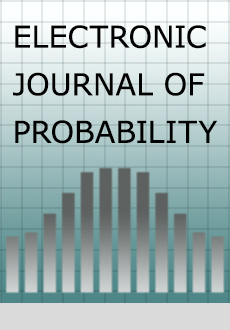Abstract
We introduce an extension of the frog model to Euclidean space and prove properties for the spread of active particles. Fix $r>0$ and place a particle at each point $x$ of a unit intensity Poisson point process $\mathcal{P} \subseteq \mathbb{R} ^d - \mathbb{B} (0,r)$. Around each point in $\mathcal{P} $, put a ball of radius $r$. A particle at the origin performs Brownian motion. When it hits the ball around $x$ for some $x \in \mathcal{P} $, new particles begin independent Brownian motions from the centers of the balls in the cluster containing $x$. Subsequent visits to the cluster do nothing. This waking process continues indefinitely. For $r$ smaller than the critical threshold of continuum percolation, we show that the set of activated points in $\mathcal{P} $ approximates a linearly expanding ball. Moreover, in any fixed ball the set of active particles converges to a unit intensity Poisson point process.
Citation
Erin Beckman. Emily Dinan. Rick Durrett. Ran Huo. Matthew Junge. "Asymptotic behavior of the Brownian frog model." Electron. J. Probab. 23 1 - 19, 2018. https://doi.org/10.1214/18-EJP215





